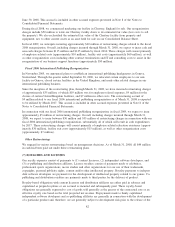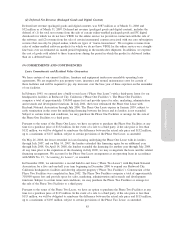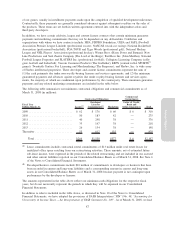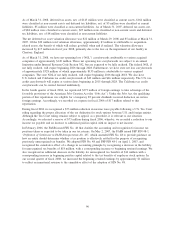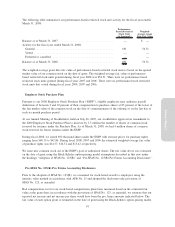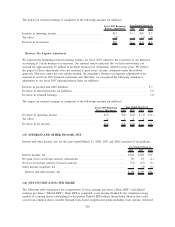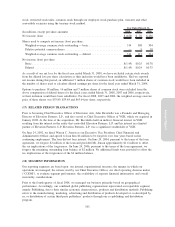Electronic Arts 2008 Annual Report Download - page 168
Download and view the complete annual report
Please find page 168 of the 2008 Electronic Arts annual report below. You can navigate through the pages in the report by either clicking on the pages listed below, or by using the keyword search tool below to find specific information within the annual report.
(11) PREFERRED STOCK
As of March 31, 2008 and 2007, we had 10,000,000 shares of preferred stock authorized but unissued. The
rights, preferences, and restrictions of the preferred stock may be designated by our Board of Directors without
further action by our stockholders.
(12) STOCK-BASED COMPENSATION AND EMPLOYEE BENEFIT PLANS
Adoption of SFAS No. 123(R)
We adopted SFAS No. 123 (revised 2004) (“SFAS No. 123(R)”), “Share-Based Payment”, as of April 1, 2006
and have applied the provisions of SAB No. 107, “Share-Based Payment”, to our adoption of SFAS No. 123(R).
We are required to estimate the fair value of share-based payment awards on the date of grant. Upon adoption
of SFAS No. 123(R), we elected to use the modified prospective transition method of adoption which requires
that compensation expense be recognized in the financial statements for all awards granted after the date of
adoption as well as for existing awards for which the requisite service has not been rendered as of the date of
adoption. Accordingly, prior periods are not restated for the effect of SFAS No. 123(R).
Prior to April 1, 2006, we accounted for stock-based awards to employees using the intrinsic value method in
accordance with APB No. 25 and adopted the disclosure-only provisions of SFAS No. 123, as amended. Also,
as required by SFAS No. 148, “Accounting for Stock-Based Compensation — Transition and Disclosure”, we
provided pro forma net income (loss) and net income (loss) per share disclosures for stock-based awards as if
the fair-value-based method defined in SFAS No. 123 had been applied.
Valuation and Expense Recognition. We recognize compensation costs for stock-based payment transactions
to employees based on their grant-date fair value over the service period for which such awards are expected
to vest. The fair value of restricted stock units is determined based on the quoted price of our common stock
on the date of grant. The fair value of stock options and stock purchase rights granted pursuant to our
employee stock purchase plan is determined using the Black-Scholes valuation model. The determination of
fair value is affected by our stock price as well as assumptions regarding subjective and complex variables
such as expected employee exercise behavior and our expected stock price volatility over the expected term of
the award. Generally, our assumptions are based on historical information and judgment is required to
determine if historical trends may be indicators of future outcomes. We estimated the following key
assumptions for the Black-Scholes valuation calculation:
•Risk-free interest rate. The risk-free interest rate is based on U.S. Treasury yields in effect at the time
of grant for the expected term of the option.
•Expected volatility. We use a combination of historical stock price volatility and implied volatility computed
based on the price of options publicly traded on our common stock for our expected volatility assumption.
•Expected term. The expected term represents the weighted-average period the stock options are
expected to remain outstanding. The expected term is determined based on historical exercise behavior,
post-vesting termination patterns, options outstanding and future expected exercise behavior.
•Expected dividends.
The assumptions used in the Black-Scholes valuation model to value our option grants and employee stock
purchase plan were as follows:
2008 2007 2008 2007
Year Ended March 31, Year Ended March 31,
Stock Option Grants Employee Stock Purchase Plan
Risk-free interest rate ......................... 1.8-5.1% 4.5-5.1% 1.7-4.2% 3.7-5.1%
Expected volatility ........................... 31-37% 31-46% 32-35% 28-36%
Weighted-average volatility..................... 33% 35% 34% 33%
Expected term .............................. 4.4years 4.2 years 6-12 months 6-12 months
Expected dividends .......................... None None None None
92


